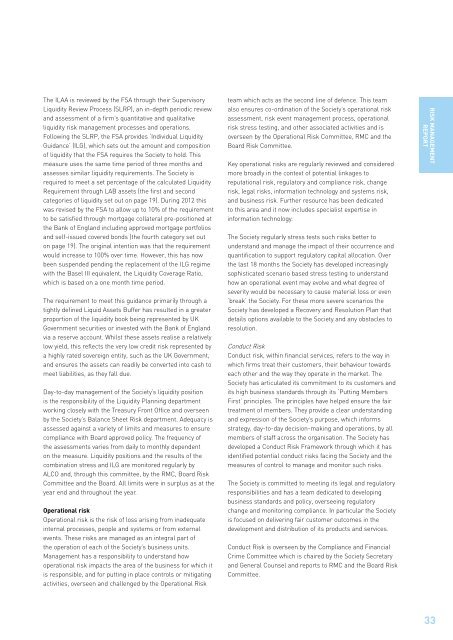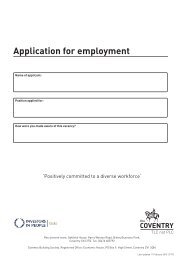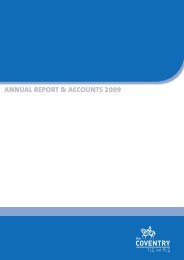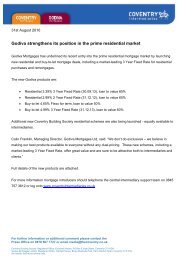ANNUAL REPORT & ACCOUNTS - Coventry Building Society
ANNUAL REPORT & ACCOUNTS - Coventry Building Society
ANNUAL REPORT & ACCOUNTS - Coventry Building Society
Create successful ePaper yourself
Turn your PDF publications into a flip-book with our unique Google optimized e-Paper software.
The ILAA is reviewed by the FSA through their SupervisoryLiquidity Review Process (SLRP), an in-depth periodic reviewand assessment of a firm’s quantitative and qualitativeliquidity risk management processes and operations.Following the SLRP, the FSA provides ‘Individual LiquidityGuidance’ (ILG), which sets out the amount and compositionof liquidity that the FSA requires the <strong>Society</strong> to hold. Thismeasure uses the same time period of three months andassesses similar liquidity requirements. The <strong>Society</strong> isrequired to meet a set percentage of the calculated LiquidityRequirement through LAB assets (the first and secondcategories of liquidity set out on page 19). During 2012 thiswas revised by the FSA to allow up to 10% of the requirementto be satisfied through mortgage collateral pre-positioned atthe Bank of England including approved mortgage portfoliosand self-issued covered bonds (the fourth category set outon page 19). The original intention was that the requirementwould increase to 100% over time. However, this has nowbeen suspended pending the replacement of the ILG regimewith the Basel III equivalent, the Liquidity Coverage Ratio,which is based on a one month time period.The requirement to meet this guidance primarily through atightly defined Liquid Assets Buffer has resulted in a greaterproportion of the liquidity book being represented by UKGovernment securities or invested with the Bank of Englandvia a reserve account. Whilst these assets realise a relativelylow yield, this reflects the very low credit risk represented bya highly rated sovereign entity, such as the UK Government,and ensures the assets can readily be converted into cash tomeet liabilities, as they fall due.Day-to-day management of the <strong>Society</strong>’s liquidity positionis the responsibility of the Liquidity Planning departmentworking closely with the Treasury Front Office and overseenby the <strong>Society</strong>’s Balance Sheet Risk department. Adequacy isassessed against a variety of limits and measures to ensurecompliance with Board approved policy. The frequency ofthe assessments varies from daily to monthly dependenton the measure. Liquidity positions and the results of thecombination stress and ILG are monitored regularly byALCO and, through this committee, by the RMC, Board RiskCommittee and the Board. All limits were in surplus as at theyear end and throughout the year.Operational riskOperational risk is the risk of loss arising from inadequateinternal processes, people and systems or from externalevents. These risks are managed as an integral part ofthe operation of each of the <strong>Society</strong>’s business units.Management has a responsibility to understand howoperational risk impacts the area of the business for which itis responsible, and for putting in place controls or mitigatingactivities, overseen and challenged by the Operational Riskteam which acts as the second line of defence. This teamalso ensures co-ordination of the <strong>Society</strong>’s operational riskassessment, risk event management process, operationalrisk stress testing, and other associated activities and isoverseen by the Operational Risk Committee, RMC and theBoard Risk Committee.Key operational risks are regularly reviewed and consideredmore broadly in the context of potential linkages toreputational risk, regulatory and compliance risk, changerisk, legal risks, information technology and systems risk,and business risk. Further resource has been dedicatedto this area and it now includes specialist expertise ininformation technology.The <strong>Society</strong> regularly stress tests such risks better tounderstand and manage the impact of their occurrence andquantification to support regulatory capital allocation. Overthe last 18 months the <strong>Society</strong> has developed increasinglysophisticated scenario based stress testing to understandhow an operational event may evolve and what degree ofseverity would be necessary to cause material loss or even‘break’ the <strong>Society</strong>. For these more severe scenarios the<strong>Society</strong> has developed a Recovery and Resolution Plan thatdetails options available to the <strong>Society</strong> and any obstacles toresolution.Conduct RiskConduct risk, within financial services, refers to the way inwhich firms treat their customers, their behaviour towardseach other and the way they operate in the market. The<strong>Society</strong> has articulated its commitment to its customers andits high business standards through its ‘Putting MembersFirst’ principles. The principles have helped ensure the fairtreatment of members. They provide a clear understandingand expression of the <strong>Society</strong>’s purpose, which informsstrategy, day-to-day decision-making and operations, by allmembers of staff across the organisation. The <strong>Society</strong> hasdeveloped a Conduct Risk Framework through which it hasidentified potential conduct risks facing the <strong>Society</strong> and themeasures of control to manage and monitor such risks.The <strong>Society</strong> is committed to meeting its legal and regulatoryresponsibilities and has a team dedicated to developingbusiness standards and policy, overseeing regulatorychange and monitoring compliance. In particular the <strong>Society</strong>is focused on delivering fair customer outcomes in thedevelopment and distribution of its products and services.Conduct Risk is overseen by the Compliance and FinancialCrime Committee which is chaired by the <strong>Society</strong> Secretaryand General Counsel and reports to RMC and the Board RiskCommittee.RISK MANAGEMENT<strong>REPORT</strong>33
















